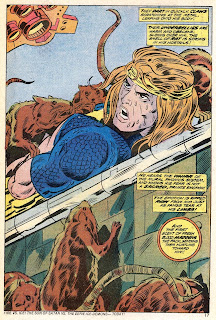
2 / 5 Stars
‘The Best SF Stories from New Worlds’ (Berkley, 1968, 158 pp.) is the US paperback version of the Panther (British) anthology published in 1967. The distinctive cover illustration is uncredited. The stories in this anthology were published in 1965 – 1967.
In his Introduction, Michael Moorcock, editor of the anthology (and also, of course of the British magazine ‘New Worlds’), invokes the ‘new spirit in sf these days’ which was of course what we now refer to as the 'New Wave' movement. So, ‘The Best SF Stories from New Worlds’ rightly may be considered one of the earliest showcases for that unique literary phenomenon.
How do the stories present upon being read more than 40 years later ?
The opening tale, ‘The Small Betraying Detail’, by Brian Aldiss, is narrated by a tubercular man who is being escorted by acquaintances to a sanitarium; en route, the narrator becomes obsessed with the idea that somehow, his companions represent another evolutionary offshoot of the human race. I found the plot device to be too contrived to be convincing, and the ending – meant to be understated, but alarming – suffers as a result.
Roger Zelazny contributes ‘The Keys to December’, in which genetically modified humans set out to terraform an entire planet. This is very much a Zelazny New Wave tale; one of his sentences lasts for nearly a page, and contains something like 20 semicolons. Under these literary contrivances, there is a modestly entertaining story.
J.G. Ballard, at the time the established star of the New Wave movement, contributes ‘The Assassination Weapon’, which is not so much a short story as it is a loosely connected series of brief paragraphs dealing with the hallucinations of a bomber pilot. It’s very much ‘experimental’ in form and construction (for example, one of the paragraphs is headed 'GOOGOLPLEX') and holds up poorly when read today.
‘Nobody Axed You’, by John Brunner, takes place in a dystopian near-future where overcrowding is so severe that sexual reproduction is outlawed, and television shows depicting acts of murder are used by the ruling authorities to inspire the populace to commit various bits of mayhem (with a goal towards keeping the population in check). Its satirical content seems more representative of 50s SF, and I suspect many readers will see the story’s denouement coming well in advance.
‘A Two-Timer’, by David I. Masson, is the best story in the collection. When a time-traveler from the future arrives in an English village in 1683, an enterprising local steals his time machine and travels forward to the same locale, albeit in 1964. There he has various humorous adventures. While a bit lengthy, the story’s appeal is that it is phrased in the dialect of a 17-century writer, i.e., “their Lamps use neither oyl nor candle, but instead, are Contrived to light by Manipulation of a special type of Ether, which they term ‘Elecktricity’.”
Langdon Jones contributes ‘The Music Makers’, in which some snobby classical musicians, performing on Mars for the benefit of its colonists, experience existential angst amid the barren dunes.
‘The Squirrel Cage’, by Thomas M. Disch, is a first-person story about a man imprisoned in a single room, perhaps by aliens. There is much musing about alienation, some of it involving pogonophore worms (the ‘tube worms’ that live around warm-water vents deep in the Pacific Ocean). The story has not aged well.
All in all, I can’t really recommend ‘The Best SF Stories from New Worlds’ to anyone but the most dedicated fans of the New Wave scene. Most of the stories seem dated by today’s standards, and I suspect contemporary readers will have little patience for the prose tricks that were deemed quite stylish back in the late 60s.













































.jpg)
.jpg)
















